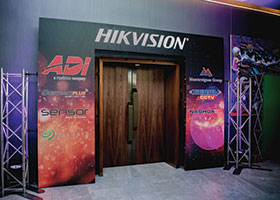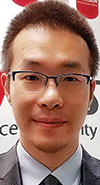

May was a busy month for exhibitions and conferences. One of the companies holding a conference was Hikvision, which hosted a full house at The Houghton Hotel for its second AI Summit in Johannesburg.
The event was opened by James Dong, CEO of Hikvision Africa, who welcomed everyone to the event. He said Hikvision’s focus was to empower its customers and community to do things in a smarter and more efficient way. As an example he mentioned issues such as using facial recognition for voting, VIP customer recognition and queue management, to name a few.

Artificial intelligence (AI) plays an increasingly important role in this regard and he advised attendees that the future will see AI everywhere.
AI Cloud and applications

Shaun Savage, project sales manager for Hikvision South Africa, presented the keynote of the day, providing an introduction to Hikvision’s AI Cloud and the ways in which we can find value from the ever-growing amount of video data by using AI. As an illustration, Savage mentioned that Hikvision has sold 180 000 IP cameras in South Africa over the past year, which are all capable of producing hundreds of petabytes of data. Processing this data manually is simply not possible.
Unlike in years past, he also noted that video data is not ‘dumb’. Images of people can be analysed for information such as facial recognition tasks for access or customer service, age and gender demographics, and even the person’s attire to allow for tracking a lost child in a red shirt or finding someone with a backpack etc. From a vehicular point of view, information such as licence plate numbers, make and colour can be obtained, as well as activity information such as speed, lane crossing, red-light jumping and more.
There is therefore a fortune in information to be extracted from video, both in real time and from stored archives.
Savage then described Hikvision’s AI Cloud solution, which is divided into three tiers, each of which has specific operations and intelligence functionality, which all work together to add value in the final solution.
The first tier is the Edge Node, where the surveillance cameras, equipped with AI (naturally) process and filter the image, removing any useless or junk data from the stream. The second tier is composed of domain servers, or your NVRs that collect video from tier 1 and add value through further analysis. The third tier is the AI Cloud where the data already filtered in the first two tiers is used to extract true AI intelligence.
Savage used a safe city scenario as an example. Tier 1 would include cameras that run functions such as facial recognition, licence plate recognition and others. The second tier adds value to this through functions such as people or vehicle tracking and further investigations. The third tier adds further value by adding additional research, warnings based on behavioural analysis and even predictions of potential problems. Controllers will be able to pull down integrated reports from multiple cameras (or other devices) and drill down into specific areas or issues.
Vertical applications
To put the possible functionality into context, Savage then provided a few example of verticals in which this type of AI functionality can be applied. Retail environments can use AI for customer analysis, people counting, heat maps and more. Additionally it could integrate various functions (people counting, PoS and facial analysis, for example) to create more intelligence that will assist the company in meeting actual customer needs.
In a banking environment, behavioural analysis at ATMs could assist in reducing crime. While armed response control rooms could use AI to integrate video verification with other alarm systems in order to ensure it only responds to actual events. Additionally, there are numerous applications for traffic enforcement where cameras can monitor traffic lights, one ways, parking violations, speeding, jaywalking and so on.
Savage then touched on some of the products Hikvision has on the market which are designed for these specific functions, such as people counting cameras and facial recognition access control.
Ruaal Tromp, senior training manager at Hikvision South Africa followed Savage with a presentation highlighting some of Hikvision’s success stories in Africa. From universities, banks, residential estates, transport utilities and more, he showed how the company has provided solutions, from cameras to facial recognition for access control and others to these and other industries across the continent.
Partner presentations
A few Hikvision partners were then on stage. Seagate was first up and Martin Kruger, META sales manager for Seagate Technology, highlighted the company’s storage solutions tailored for the surveillance market, as well as a new technology the company has developed. HAMR technology (Heat Assisted Magnetic Recording) has the future potential to deliver hard drives with 100 TB capacities.
Vumacam was also on hand to talk about its plans to create the largest video surveillance network in the country. Currently the PoPIA-compliant system consists of over 1100 cameras in over 100 suburbs, and the company can boast a 99.1% uptime.
Bill Hongda Xu, marcom director of Hikvision Africa closed the event with thanks to all involved before a networking session began in the Houghton’s plush lobby.
For more information contact Hikvision South Africa, +27 10 035 1172, [email protected], www.hikvision.com
| Tel: | +27 10 085 8300 |
| Email: | [email protected] |
| www: | www.hikvision.com/africa/ |
| Articles: | More information and articles about Hikvision South Africa |
| Tel: | +27 11 543 5800 |
| Email: | [email protected] |
| www: | www.technews.co.za |
| Articles: | More information and articles about Technews Publishing |
© Technews Publishing (Pty) Ltd. | All Rights Reserved.